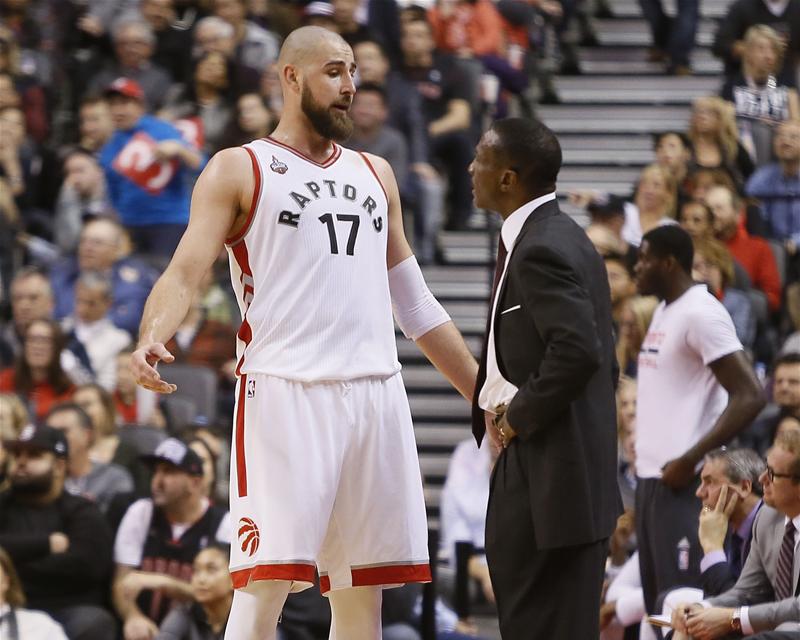The ketchup bottle theory goes roughly like this: If something isn’t working despite your best efforts, keep trying. Eventually, you’ll see a small amount of success, then a great deal more; once success finally starts, it begins flowing freely.
Patrick Patterson and the Toronto Raptors are awash in metaphorical ketchup.
The theory is silly, a roundabout way of employing the flawed Gambler’s Fallacy. Applied more loosely, it’s simply a reminder to keep plugging away. Keep trying. In the case of Patterson and a corps of struggling shooters, keep shooting.
That’s what the Raptors did against the New Orleans Pelicans on Friday in a 100-81 victory that followed what’s becoming all too familiar a formula.
The Raptors started out slow, particularly on the offensive end of the floor, making the second half more difficult than it maybe needed to be against a 1-8 team missing its superstar in Anthony Davis and four other rotation players. Early miscues and errant shots from anyone not named Jonas Valanciunas continued the trend of Toronto struggling to score early, their first-quarter offense now last in the NBA in points per-100 possessions.
Things got moderately better in the second quarter, enough for the Raptors to enter the break squared away at 40-40.
The freshly chromed-out dome of Valanciunas, looking like the newest member of the Wyatt Family, was the story of the half, though not for aesthetic reasons. Valanciunas was at his two-way best, carrying the moribund offense with 15 first-half points and four offensive rebounds. He’d finish the game with 20 points, 10 rebounds, and two blocks with an 8-of-11 mark from the floor, truly one of the best all-around performances of what’s been a very strong start to his 2015-16 season.
“Jonas is growing up,” head coach Dwane Casey said after the game. “I’ve been preaching that now since I’ve been here, it’s just going to take time.”
Fan ire at Valanciunas watching fourth quarters from the bench is now fan dismay when Valanciunas plays late in a game that’s well in hand. The latter was the case Friday in large part because of the damage the Lithuanian did in the post, from mid-range, and in snuffing out the Pelicans’ pick-and-roll offense.
Carried by Valanciunas for 24 minutes, his teammates awoke; as has been the case on many nights already, a switch seemingly turned on during halftime. The Raptors came out of the half on fire, shooting 13-of-23 from the floor, good for 21 points and an 11-point lead. In stark contrast to their first-quarter offense, their third-quarter offense is the best in the NBA.
More specifically and more notably, four-of-six 3-point attempts dropped in the third, a marked reversal from a somewhat uncharacteristic but not altogether unexpected six-game shooting slump. Two weeks of long-range futility despite generating open looks wasn’t cause for a strategic shift to a Byron Scottian approach, and the Raptors’ continued moderate use of the triple paid dividends.
DeMar DeRozan was not among those contributing from outside, but his improved drive-and-kick game was on point in response to aggressive defensive attention. He tallied 11 assists, one shy of his career high and just the second time he’s cracked double-figures in his career. Five of those dimes led to Raptors’ triples, with DeRozan’s singular ability to draw help off the bounce opening passing lanes he exploited willingly.
Toronto cruised following the strong third, opening up a 20-point lead early in the fourth quarter and turning to a bench mob with a few minutes left to play. They finished 9-of-21 from outside for the game, and non-Valanciunas Raptors shot 20-of-36 in the second half after posting a woeful 6-of-30 mark in the first half.
Patterson canned two triples himself, a sort of canary in the coalmine for the team’s troubles from outside. A two-of-five night is nothing that jumps off the box score – he finished with 10 points and one rebound in 22 minutes – but there has to be a sense of relief to snap out of a perceived slump, even one that’s occurred over a relatively small sample thanks to the low-event nature of outside shooting.
“I’m always confident in my game,” Patterson said afterward. “The only thing that really matters to me is defense. As long as I’m effective on the defensive end, talking, communicating, and covering my responsibilities, the rest will take care of itself. When my shot falls, my confidence goes up. Progressively, the offense is starting to flow and that’s better for me.”
The team’s shooting also received a theoretical boost with the return of DeMarre Carroll, though he shot 1-of-5 in his first game back after a three-game respite to rest a case of plantar fasciitis in his right foot. Carroll is one of the team’s better outside shooters despite a mini-slump of his own to start the year, and his presence at least has a gravitational pull on an opposing defense, whether or not his shots fall.
His return was also quite notable at the defensive end, where Carroll helped slow down Eric Gordon after a red-hot first half – he somewhat unfairly put the blame for Gordon’s 20-point half on his own shoulders – and on the glass, where he crashed for three offensive boards and five overall. Like Patterson and the team as a whole, faith that the shots will eventually fall must be upheld while the focus shifts to other areas of contribution.
“I feel that even when my shot’s not falling, I can impact the game in so many ways,” Carroll said. “Once my shots start falling, that’s when you need to watch out. It’s going to come.”
It sounds like he’s talking about the ketchup bottle theory.




